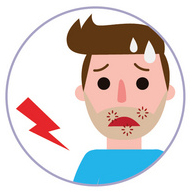How long is which viral infection contagious?

Colds, gastrointestinal infections or actual flu: many infectious diseases are caused by viruses. Antibiotics are powerless against the tiny creatures, and in emergencies only special virostatic medicines can be effective. "Therefore hygiene, or vaccinations if available, are the most important measures to prevent infecting other people," says Professor Dr. Hartmut Hengel, Medical Director of the Institute of Virology at the Medical Center - University of Freiburg. Some pathogens multiply in the body for much longer than the person affected is aware. During the incubation period, they multiply before they cause clinical symptoms. And after the symptoms have faded, they sometimes survive days or even weeks and lead to contagions.
Protect yourself and others
Hands are a major transmission route for many viral diseases. Which is why you should wash your hands often if you suspect an infection, for example after you have wiped your nose, rubbed your eyes and after going to the toilet. Even after contact with an infected person, it is important to think about washing your hands. Sick people should be careful to sneeze only in their elbows and not to share towels in cases of diarrheal disease.
Real flu (influenza)
Viral pathogens: Influenza A and B viruses
Incubation period: 1 – 3 days
Symptoms: Fever, cough, pain in neck, head and limbs
Contagion duration: 1 week during the symptoms
Characteristics: Sudden onset, sometimes severe course
Flu-like infection ("sniffles", "cold", "summer flu")
Viral pathogens: Enteroviruses, coxsackieviruses, echoviruses, rhinoviruses, parainfluenza viruses
Incubation period: 2 – 14 days
Symptoms: Runny nose, sore throat, muscle pains, cough, rash
Contagion duration: 1 week during the symptoms
Characteristics: Slow onset, usually mild course
Lip herpes ("cold sores")
Viral pathogens: Herpes simplex virus
Incubation period: 2 – 12 days, initial infection often symptomless
Symptoms: Tension, itching and burning; liquid-filled blisters
Contagion duration: As long as blisters are visible (open or closed)
Characteristics: The viruses stay in the body for life; stress and infections reactivate them
Conjunctivitis
Viral pathogens: Adenoviruses, enteroviruses, coxsackieviruses, measles virus, herpes simplex virus
Incubation period: 5 – 14 days
Symptoms: Eyes red, irritated, strong stream of tears, swollen eyelids
Contagion duration: Up to four weeks during the symptoms
Characteristics: Highly contagious, for example from shaking hands, keyboards, towels etc.
Gastroenteritis
Viral pathogens: Noroviruses, adenoviruses, rotaviruses, astroviruses
Incubation period: 10 – 48 hours
Symptoms: Sudden onset of diarrhea, nausea and vomiting; usually over after 12 - 48 hours
Contagion duration: Up to 2 weeks
Characteristics: Extremely infectious, about ten viral particles are enough
Three-day fever (in infants and toddlers)
Viral pathogens: Human herpes viruses 6 and 7 (roseolovirus)
Incubation period: 5 – 17 days
Symptoms: Strong fever, abrupt decline after 3 - 4 days
Contagion duration: During the fever phase
Characteristics: After the fever subsides, a strong rash develops
Back